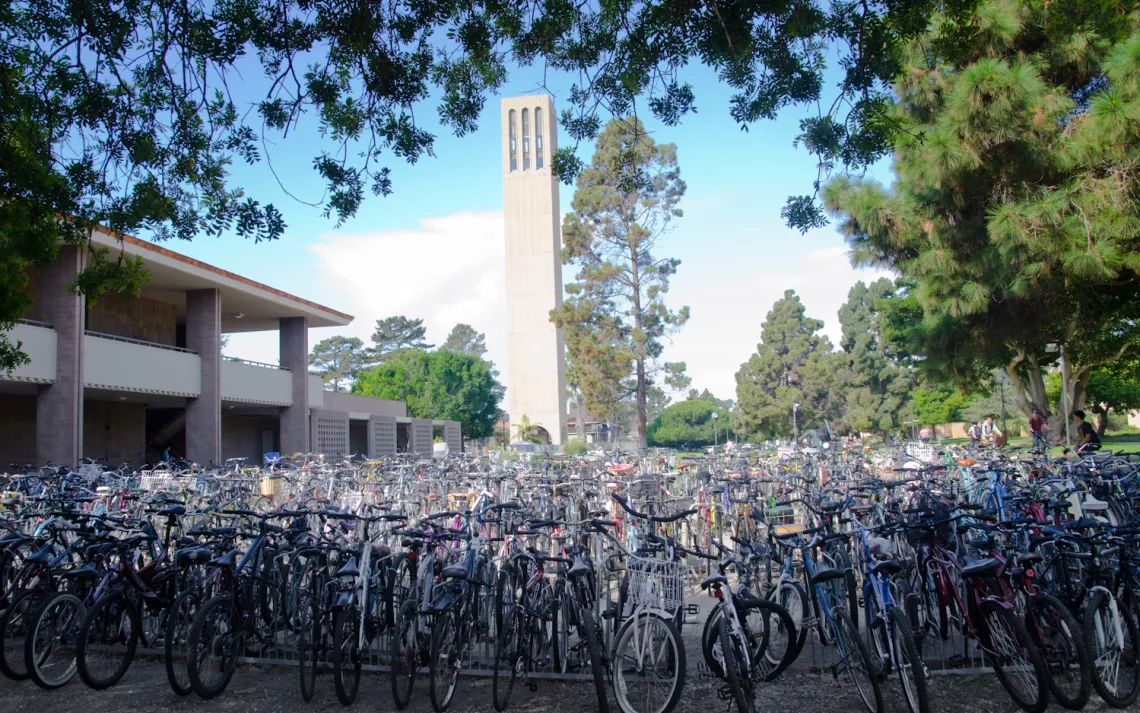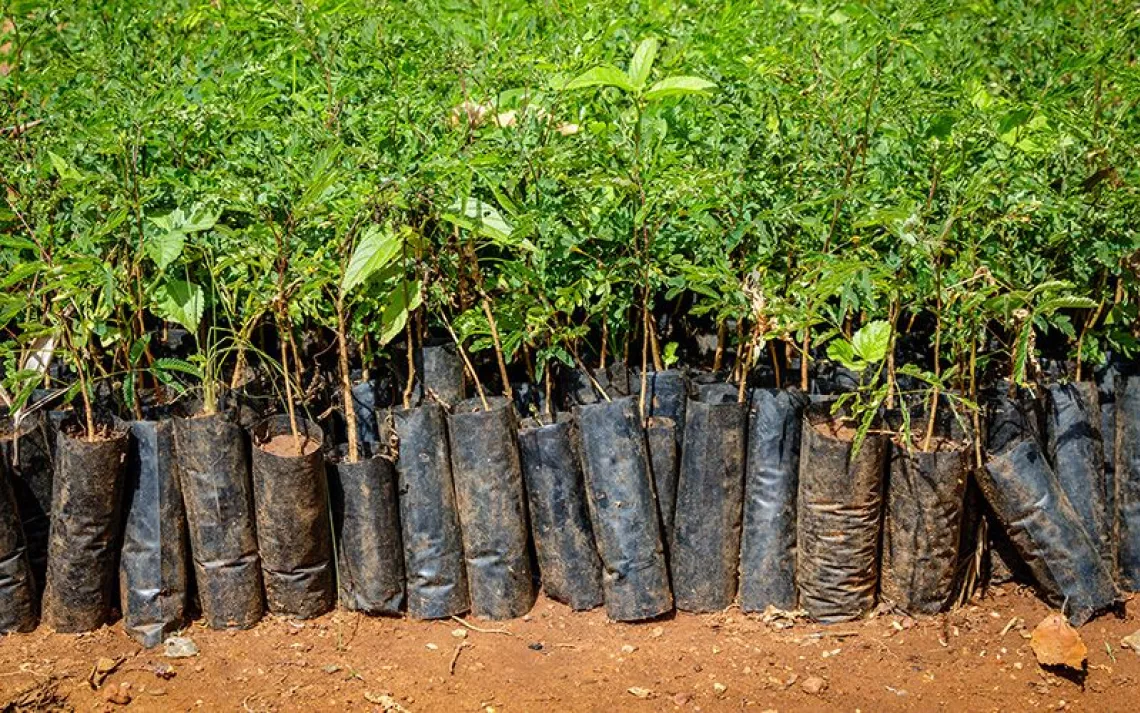Cool Schools 2013: The Top Ten Coolest Schools
September 15, 2013

10: UNIVERSITY OF CALIFORNIA, SANTA BARBARA
Santa Barbara, California
SCORE: 756.69 | STUDENTS: 22,218
UCSB puts up formidable numbers: 44 of its buildings are LEED certified, 47% of academic departments offer a class about sustainability (for a total of 321 classes and 217 faculty members who do eco-research), 50% of food served is local, and 75% of waste gets saved from the landfill via recycling and composting; the goal is to get that latter percentage to 100 by 2020. The Gauchos have also, since the late 1990s, lowered their electricity use by a third (10 on-campus photovoltaic systems help), their water use by a quarter, and their food waste by almost 35%. A whopping 94% of students take alternative means of transit to class—there are more than 10,000 bicycle parking spaces on campus to accommodate 10 miles of bike paths.
Photo courtesy of Jonas Krant/UC Santa Barbara

9: AMERICAN UNIVERSITY
Washington, D.C
SCORE: 759.34 | STUDENTS: 12,693
Aiming to be carbon neutral by 2020, AU is off to a strong start, with 30 buildings on track for LEED Silver certification, a 27-kilowatt solar array, D.C.'s biggest solar hot-water system, and a contraption called the Vegawatt, which turns old cooking oil into electricity. The university's plan is to divert 100% of its waste, and it's already two-thirds of the way there, thanks to a new campus-wide composting program, trayless dining (which reduced food waste by a third), quarterly e-waste drives, and such enthusiastic student participation that AU won last year's national RecycleMania competition. Students also get excited about the annual Campus Beautification Day (shown above), a springtime tradition that brings the AU community together to make the campus greener.
Photo courtesy of Jeff Watts/American University

8: GEORGIA INSTITUTE OF TECHNOLOGY
Atlanta, Georgia
SCORE: 759.76 | STUDENTS: 20,941
The EPA named Georgia Tech one of the "best places for commuters" for its range of eco-transit options, from carpooling to mass transit; natural gas–powered buses move more than 2 million riders per year. Above, as part of Georgia Tech's annual Earth Day celebration—one of the Southeast's biggest—student volunteers offer free bicycle repairs. The 440-acre Atlanta school was also named a Tree Campus USA for its 25% arboreal cover. Despite all that foliage, water usage hasn't increased since 2001—impressive, considering that the school's interior square footage has doubled since then. Everything built after 2008 is LEED certified, and a 1.4-million-gallon stormwater cistern helps conserve. The Yellow Jackets have been recycling since 1996, diverting an annual mass of 600 tons.
Photo courtesy of Rob Felt/Georgia Institute of Technology

7: STANFORD UNIVERSITY
Palo Alto, California
SCORE: 763.82 | STUDENTS: 15,666
"Sustainability must become a core value in everything we do," wrote Stanford president John Hennessy. Over five years, the California school raised more than $430 million for its Initiative on the Environment and Sustainability. The Stanford Energy System Innovations program is building a new energy facility that'll halve the 8,180-acre campus's CO2 emissions and cut its water use by almost a fifth. Some 130 professors spanning 40 departments teach 700-plus sustainability-related classes. No surprise, then, that three dozen student clubs are green-themed and that recycling and composting are big: The waste-diversion rate here tops 66%, and the goal is zero waste. The students in the above photo might look like lacrosse players, but they're members of the Stanford Gleaning Project on their way to harvest loquats from the campus's Main Quadrangle; the fruit is donated to local hunger-relief organizations.
Photo courtesy of Linda A. Cicero/Stanford News Service


6: GREEN MOUNTAIN COLLEGE
Poultney, Vermont
SCORE: 767.09 | STUDENTS: 637
With grounds as verdant as its name, GMC is a tiny school in Poultney, Vermont, that describes itself as "a liberal-arts college emphasizing environmental sustainability." One of the first U.S. universities to achieve climate neutrality, it has a $5.8 million biomass plant that burns locally sourced woodchips (instead of fuel oil) to heat 85% and power 20% of the campus's two dozen buildings. Since 2006, GMC has also sourced 1.2 million kilowatt-hours of its energy per year from cows. Students visit local farms to learn about the bovine methane-generating process and are required to take a 37-credit environmental curriculum, which is delivered in LEED-certified classrooms. Above, GMC students plant trees to create a riparian buffer along the banks of the Poultney River.
Photo courtesy of Don Hamerman/Green Mountain College

5: CORNELL UNIVERSITY
Ithaca, New York
SCORE: 776.72 | STUDENTS: 21,131
Cornell offers 340 classes, across almost every department, about sustainability, and this is one of the only colleges where you can minor in climate change. School officials pledge that Cornell will be a net-zero-carbon campus by 2050. Over the past two years, its greenhouse gas emissions have dropped by 25%, and over the next five, $45 million will go toward energy-conservation projects: Cornell has already added more than 1 million square feet of new construction without needing to use any additional power. Plenty of open space remains, however: The 2,300-acre campus in Ithaca, New York, has two stunning gorges, a 35-acre botanical garden, and a 100-acre arboretum. Above, at the annual Slope Day, celebrating the last day of classes, student volunteers collect recyclables and compostables.
Photo courtesy of Lindsay France/Cornell University Photography

4: UNIVERSITY OF CALIFORNIA, DAVIS
Davis, California
SCORE: 782.74 | STUDENTS: 32,653
Last year's "Cool Schools" winner, an agricultural-education powerhouse, churns out research that helps shape California's water laws and push new farming practices into the mainstream. Its West Village, a neighborhood for students and staff, is America's biggest planned zero-net-energy community. UC Davis's climate action plan has already cut campus emissions to below year-2000 levels. Recycling, composting, and reuse divert more than 60% of would-be trash from landfills, and the Aggies aim to lift that percentage to 100 by 2020. In the photo above, freshman Julia Wasielewski fills junior Soo Lee's bag with local produce at the on-campus farmers' market, a weekly event during fall and spring quarters.
Photo courtesy of Karin Higgins/UC Davis

3: UNIVERSITY OF CALIFORNIA, IRVINE
Irvine, California
SCORE: 794.30 | STUDENTS: 27,479
UC Irvine's 19-megawatt cogeneration facility and other energy-preserving projects have helped the school save 20 million kilowatt-hours of electricity per year since 2009—and solar panels generate enough power to run 500 homes for a year. The 1,475-acre campus is anchored by a 16-acre botanical garden, and all new buildings must be certified at least LEED Silver. Living green is important at UCI: Meatless Mondays are strongly encouraged, and a dozen student clubs focus on eco-issues. Above, graduate students in UCI's Earth System Science Department learn about Mono Lake's geology, ecology, natural history—and about environmentalists' efforts to protect the lake—during a spring-break field trip.
Photo courtesy of Kathleen Johnson/UC Irvine

2: DICKINSON COLLEGE
Carlisle, Pennsylvania
SCORE: 807.04 | STUDENTS: 2,380
Since 2008, Dickinson has bought enough wind power to offset all of its electrical needs. And since 2006, students have been collecting grease from local restaurants and turning it into biodiesel for the Carlisle, Pennsylvania, campus's vehicle fleet. If all goes according to plan, the school will achieve zero net emissions by 2020. Meanwhile, cafeterias serve student-grown produce, construction crews build to LEED Gold standards, and paper use has dropped by 60% over the past four years. Above, students install solar panels to power an irrigation pump at Dickinson's certified-organic College Farm.
Photo courtesy of Jennifer Crowley/Dickinson College

1: UNIVERSITY OF CONNECTICUT
Storrs, Connecticut
SCORE: 850.14 | STUDENTS: 22,301
This year's winning school offers almost 600 sustainability-related classes taught by some of the greenest minds anywhere—more than 40% of UConn's research faculty does original academic work that benefits the environment. Since 2005, the main campus, in Storrs, has slashed its water use by 15%—and over the past two years, 13 of its buildings were retrofitted to prevent 2,640 tons of carbon dioxide emissions annually. In the trayless dining halls, 30% of meal options are vegetarian, and more than a quarter of the food is processed within 100 miles, with many ingredients harvested right on campus: Honey comes from UConn's apiaries, fresh eggs from the agriculture department, and seasonal produce from student-run gardens (shown above). Farther afield, the school's Forest Committee tends more than 2,000 acres of open space.
Photo courtesy of Peter Morenus/University of Connecticut
Avital Andrews is Sierra's former lifestyle editor. Follow her on Twitter @avitalb.
More articles by this author- Keywords:
- cool schools
 The Magazine of The Sierra Club
The Magazine of The Sierra Club



